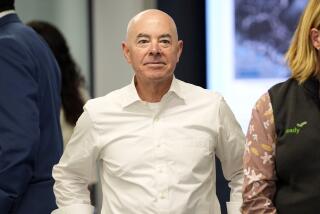China Airlines Records Loss, Political Profit
- Share via
TAIPEI — China Airlines has recorded a substantial loss for the third successive year, but there is little sign of concern within the gleaming steel headquarters of Taiwan’s flag carrier.
To outsiders, the privately owned airline might appear to have problems. It suffered a loss of $15 million in 1984. It flies unprofitable routes, one where planes are often half-empty. Its liabilities--$1.06 billion--have reached 93% of its $1.1 billion in total assets.
But China Airlines is a private carrier with a difference.
“All our loans are guaranteed by the government,” said a ranking airline executive, who declined to be identified. “The government compensates us for unprofitable routes, inaugurated and maintained for political reasons.”
Economic Power
Diplomatically isolated and dwarfed by the communist mainland, Taiwan’s ace is its economic power--and the Nationalist Chinese government believes the airline’s financial loss is outweighed by its political profit.
The airline now flies to 21 cities worldwide, including New York, San Francisco, Los Angeles and Honolulu, but carried only 2.09 million passengers in 1984, down from a peak of 2.8 million in 1977.
It has still been seeking to develop new routes. Its two most recent coups were obtaining landing rights in New York and Amsterdam, both in 1983.
To obtain these rights, China Airlines had to act as a private enterprise separate from the government, since Taiwan does not have official relations with either the United States or the Netherlands.
But the cost of this indirect diplomacy is high. New routes have required new, expensive aircraft, bringing new debts, new interest payments--and more losses.
Last year, China Airlines made an operating profit of $11 million, but it was more than offset by $30 million in interest payments and on the lease of four Airbus A-300s and a Boeing 747 cargo liner.
Preferential Terms
The losses might have been higher if the company bought those aircraft--the Airbuses cost about $200 million--but the government stepped in, purchasing the planes and leasing them back at preferential terms.
The airline expects its debt burden to fall sharply after 1987, a year viewed as critical by one company official.
“If the airline can be tided over through 1987, then the future will look much brighter,” he said, adding the best chance for the turnaround will come from concentrating on profitable routes rather than opening new ones.
“We should stay in the Pacific, particularly Japan, Hong Kong and the Philippines, known as golden routes, where we make most of our profits,” he said.
The government, however, is delighted with the exposure its “political” flights have brought to the island, which has diplomatic relations with only 25 nations.
“It is just on these routes that we have suffered our worst losses,” said the official. “But China Airlines has more to consider than commercial concerns. We are in business to promote our government.”
Only 47% Occupancy
Amsterdam, the first European destination to which China Airlines flies, is a prime example of its difficulty. The two weekly flights averaged only 47% occupancy in 1984, compared to 70% on Asian routes.
But having been granted “diplomatic” landing rights in Amsterdam, China Airlines has been encouraged by the government to exploit the privilege, said an official of Taiwan’s Civil Aeronautics Administration.
So the CAA agreed to lease the four A-300s to the airline at preferential terms to fly the routes, the official said.
Operating this way has blurred the fine line between private and government involvement in the airline, provoking sharp criticism from both parliament and press on why taxpayer funds subsidize a private concern.
“The government subsidy to China Airlines in 1984 exceeded $8.25 million and is expected to almost double to $16 million in 1985,” complained legislator Lin Yu-hsiang.
“From the private sector China Airlines derives nepotism, from the state comes secrecy,” a Taipei newspaper observed.
But a blend of public and private sectors is nothing new to China Airlines, which was founded in 1959 by retired air force pilots flying a pair of PBY seaplanes and a lone C-46 transport.
Although the firm officially maintains its independence, a spokesman conceded it enjoys a wide range of support. Foreign analysts assert its officials consult the government on all policy decisions.
All China Airlines pilots and many ground staff workers are supplied by the Taiwan air force. Its chairman, Wu Yueh, is a former air force commander in chief and many of its top executives are retired air force officers.
More to Read
Sign up for Essential California
The most important California stories and recommendations in your inbox every morning.
You may occasionally receive promotional content from the Los Angeles Times.













